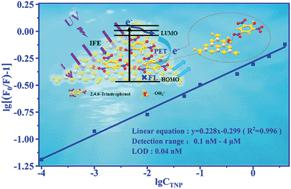当前位置:
X-MOL 学术
›
Environ. Sci.: Nano
›
论文详情
Our official English website, www.x-mol.net, welcomes your
feedback! (Note: you will need to create a separate account there.)
The synthesis of porous ultrathin graphitic carbon nitride for the ultrasensitive fluorescence detection of 2,4,6-trinitrophenol in environmental water
Environmental Science: Nano ( IF 5.8 ) Pub Date : 2019-11-26 , DOI: 10.1039/c9en01165j Binhong Qu 1, 2, 3, 4, 5 , Zhiyuan Mu 1, 2, 3, 4, 5 , Yang Liu 1, 2, 3, 4, 5 , Yingsha Liu 1, 2, 3, 4, 5 , Rui Yan 1, 2, 3, 4, 5 , Jianhui Sun 1, 2, 3, 4, 5 , Zishu Zhang 1, 2, 3, 4, 5 , Peng Li 1, 2, 3, 4, 5 , Liqiang Jing 1, 2, 3, 4, 5
Environmental Science: Nano ( IF 5.8 ) Pub Date : 2019-11-26 , DOI: 10.1039/c9en01165j Binhong Qu 1, 2, 3, 4, 5 , Zhiyuan Mu 1, 2, 3, 4, 5 , Yang Liu 1, 2, 3, 4, 5 , Yingsha Liu 1, 2, 3, 4, 5 , Rui Yan 1, 2, 3, 4, 5 , Jianhui Sun 1, 2, 3, 4, 5 , Zishu Zhang 1, 2, 3, 4, 5 , Peng Li 1, 2, 3, 4, 5 , Liqiang Jing 1, 2, 3, 4, 5
Affiliation

|
The ultrasensitive detection of 2,4,6-trinitrophenol (TNP) for environmental security is important but challenging. Graphitic carbon nitride (g-C3N4) is promising for the fluorescence sensing of TNP. It is highly desired to greatly promote the adsorption of TNP onto g-C3N4 for improving the fluorescence detection sensitivity. Herein, porous ultrathin g-C3N4 (∼1.3 nm) nanosheets were successfully synthesized via combining second calcination with HNO3 treating processes. Under the optimized conditions of the excitation wavelength (Ex = 350 nm) and solution pH value (pH = 3), the wide detection range of TNP from 4 μM to 54 μM was confirmed by the widely adopted normal Stern–Volmer equation (SVE). Interestingly, the limit of detection was as low as 0.04 nM according to the linear range from 0.1 nM to 4 μM by the generally neglected double logarithmic (DL) SVE, which is much competitive for TNP detection compared with previously reported results. Based on the isothermal adsorption curves and the time-resolved fluorescence and surface photovoltage spectra, it was confirmed that the multilayer adsorption of TNP on the resulting g-C3N4 at low concentrations mainly led to fluorescence quenching by the inner filter effect (IFE), while the monolayer adsorption at ultralow concentrations resulted in fluorescence quenching by the combined effects of IFE and photoinduced electron transfer. It was suggested that normal and DL SVEs are applicable to the fluorescence quenching processes determined by single and double factors, respectively. The obtained ultrasensitive detection was attributed to the greatly promoted adsorption of TNP via hydrogen bonding by enlarging the surface area from the porous nanosheet structure and by increasing the surface –OH sites from the HNO3 treatment. This work helps to deeply understand SVE related to the fluorescence quenching processes and provides a feasible route to develop a method for the ultrasensitive detection of TNP with g-C3N4 nanosheets for environmental water monitoring and security inspection.
中文翻译:

多孔超薄石墨氮化碳的合成用于环境水中2,4,6-三硝基苯酚的超灵敏荧光检测
为了环境安全,对2,4,6-三硝基苯酚(TNP)进行超灵敏检测固然重要,但却极富挑战。石墨化的氮化碳(gC 3 N 4)有望用于TNP的荧光传感。强烈期望极大地促进TNP在gC 3 N 4上的吸附,以提高荧光检测的灵敏度。在此,通过将第二次煅烧与HNO 3结合成功地合成了多孔超薄gC 3 N 4(〜1.3 nm)纳米片处理过程。在激发波长(Ex = 350 nm)和溶液pH值(pH = 3)的最佳条件下,通过广泛采用的标准Stern-Volmer方程(SVE)确认了TNP的检测范围从4μM到54μM。 。有趣的是,根据通常被忽略的双对数(DL)SVE,从0.1 nM到4μM的线性范围,检出限低至0.04 nM,与先前报道的结果相比,其在TNP检测中具有很大的竞争力。根据等温吸附曲线以及时间分辨的荧光和表面光电压光谱,证实了TNP在所得gC 3 N 4上的多层吸附。在低浓度下,主要通过内滤效应(IFE)导致荧光猝灭,而在超低浓度下的单层吸附则通过IFE和光诱导电子传递的联合作用而导致了荧光猝灭。建议正常和DL SVE分别适用于由单因素和双重因素确定的荧光猝灭过程。所获得的超灵敏检测归因于通过增加多孔纳米片结构的表面积并通过增加HNO 3的表面-OH位置,通过氢键大大促进了TNP的吸附。治疗。这项工作有助于深入了解与荧光猝灭过程有关的SVE,并为开发一种用gC 3 N 4纳米片超敏检测TNP的方法进行环境水监测和安全检查提供了一条可行的途径。
更新日期:2019-11-26
中文翻译:

多孔超薄石墨氮化碳的合成用于环境水中2,4,6-三硝基苯酚的超灵敏荧光检测
为了环境安全,对2,4,6-三硝基苯酚(TNP)进行超灵敏检测固然重要,但却极富挑战。石墨化的氮化碳(gC 3 N 4)有望用于TNP的荧光传感。强烈期望极大地促进TNP在gC 3 N 4上的吸附,以提高荧光检测的灵敏度。在此,通过将第二次煅烧与HNO 3结合成功地合成了多孔超薄gC 3 N 4(〜1.3 nm)纳米片处理过程。在激发波长(Ex = 350 nm)和溶液pH值(pH = 3)的最佳条件下,通过广泛采用的标准Stern-Volmer方程(SVE)确认了TNP的检测范围从4μM到54μM。 。有趣的是,根据通常被忽略的双对数(DL)SVE,从0.1 nM到4μM的线性范围,检出限低至0.04 nM,与先前报道的结果相比,其在TNP检测中具有很大的竞争力。根据等温吸附曲线以及时间分辨的荧光和表面光电压光谱,证实了TNP在所得gC 3 N 4上的多层吸附。在低浓度下,主要通过内滤效应(IFE)导致荧光猝灭,而在超低浓度下的单层吸附则通过IFE和光诱导电子传递的联合作用而导致了荧光猝灭。建议正常和DL SVE分别适用于由单因素和双重因素确定的荧光猝灭过程。所获得的超灵敏检测归因于通过增加多孔纳米片结构的表面积并通过增加HNO 3的表面-OH位置,通过氢键大大促进了TNP的吸附。治疗。这项工作有助于深入了解与荧光猝灭过程有关的SVE,并为开发一种用gC 3 N 4纳米片超敏检测TNP的方法进行环境水监测和安全检查提供了一条可行的途径。











































 京公网安备 11010802027423号
京公网安备 11010802027423号